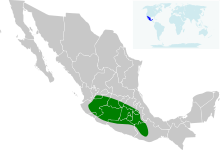Allen's yellow bat
Allen's yellow bat (Rhogeessa alleni) is a species of vesper bat. There is some taxonomic debate surrounding this species, with some authors considering Baeodon a genus rather than a subgenus. It is endemic to Mexico.
| Allen's yellow bat | |
|---|---|
| Scientific classification | |
| Kingdom: | Animalia |
| Phylum: | Chordata |
| Class: | Mammalia |
| Order: | Chiroptera |
| Family: | Vespertilionidae |
| Genus: | Rhogeessa |
| Species: | R. alleni |
| Binomial name | |
| Rhogeessa alleni Thomas, 1892 | |
 | |
| Synonyms | |
| |
Taxonomy and etymology
It was described as a new species in 1892 by British zoologist Oldfield Thomas. Thomas noted that the eponym for the species name "alleni" was Harrison Allen, calling him "the chief authority on North-American bats."[2] In 1906, Gerrit Smith Miller placed Allen's yellow bat into a newly-coined genus, Baeodon.[3] At present, some authors keep Allen's yellow bat as part of Rhogeessa within the subgenus Baeodon[4], while others believe that it is distinct enough that Baeodon should be considered a monotypic genus rather than a subgenus.[5]
Description
It is a small species of bat, weighing only 5.8–8 g (0.20–0.28 oz).[6] It has large ears, with long tragi. The tragi are rounded at the tips, with a straight or slightly concave inner margin and a slightly convex outer margin. The posterior edges of its wings are white. It has a small and narrow calcar. The head and body is 47 mm (1.9 in), while the tail is 41 mm (1.6 in) long. Its forearm length is 35 mm (1.4 in).[2] Its dental formula is 1.1.1.33.1.2.3 for a total of 30 teeth.[6]
Range and habitat
It is endemic to Mexico, with its range encompassing several states in southwest Mexico.[6] It has been documented at a range of elevations, from 125–1,990 m (410–6,529 ft) above sea level.[1] However, most records of this species are at elevations greater than 1,000 m (3,300 ft) above sea level. Its habitat consists of tropical deciduous forests, thorny forests, deciduous forests, and xeric shrublands.[6]
Conservation
It is currently evaluated as least concern by the IUCN—its lowest conservation priority. It meets the criteria for this assessment because it has a large geographic range; its range includes protected areas; and it lacks major threats to its continued existence.[1] However, it is infrequently encountered and is considered rare or locally uncommon.[6]
References
- Solari, S. (2019). "Baeodon alleni". The IUCN Red List of Threatened Species. 2019: e.T19679A21989577. doi:10.2305/IUCN.UK.2019-1.RLTS.T19679A21989577.en.
- Thomas, O. (1892). "Description of a new Mexican bat". The Annals and Magazine of Natural History; Zoology, Botany, and Geology. 6. 10 (60): 477–478. doi:10.1080/00222939208677451.
- Miller, G.S. (1906). "Twelve new genera of bats". Proceedings of the Biological Society of Washington. 19: 85.
- Wilson, D.E.; Reeder, D.M., eds. (2005). Mammal Species of the World: A Taxonomic and Geographic Reference (3rd ed.). Johns Hopkins University Press. ISBN 978-0-8018-8221-0. OCLC 62265494.
- Roehrs, Zachary P.; Lack, Justin B.; Van Den Bussche, Ronald A. (2010). "Tribal phylogenetic relationships within Vespertilioninae (Chiroptera: Vespertilionidae) based on mitochondrial and nuclear sequence data". Journal of Mammalogy. 91 (5): 1073–1092. doi:10.1644/09-MAMM-A-325.1.
- Ceballos, G. (2014). Mammals of Mexico. JHU Press. p. 830. ISBN 978-1421408439.
